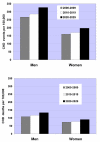The future impact of population growth and aging on coronary heart disease in China: projections from the Coronary Heart Disease Policy Model-China
- PMID: 19036167
- PMCID: PMC2631484
- DOI: 10.1186/1471-2458-8-394
The future impact of population growth and aging on coronary heart disease in China: projections from the Coronary Heart Disease Policy Model-China
Abstract
Background: China will experience an overall growth and aging of its adult population in coming decades. We used a computer model to forecast the future impact of these demographic changes on coronary heart disease (CHD) in China.
Methods: The CHD Policy Model is a validated state-transition, computer simulation of CHD on a national scale. China-specific CHD risk factor, incidence, case-fatality, and prevalence data were incorporated, and a CHD prediction model was generated from a Chinese cohort study and calibrated to age-specific Chinese mortality rates. Disability-adjusted life years (DALYs) due to CHD were calculated using standard methods. The projected population of China aged 35-84 years was entered, and CHD events, deaths, and DALYs were simulated over 2000-2029. CHD risk factors other than age and case-fatality were held at year 2000 levels. Sensitivity analyses tested uncertainty regarding CHD mortality coding, the proportion of total deaths attributable to CHD, and case-fatality.
Results: We predicted 7.8 million excess CHD events (a 69% increase) and 3.4 million excess CHD deaths (a 64% increase) in the decade 2020-2029 compared with 2000-2009. For 2030, we predicted 71% of almost one million annual CHD deaths will occur in persons >or=65 years old, while 67% of the growing annual burden of CHD death and disability will weigh on adults <65 years old. Substituting alternate CHD mortality assumptions led to 17-20% more predicted CHD deaths over 2000-2029, though the pattern of increases in CHD events and deaths over time remained.
Conclusion: We forecast that absolute numbers of CHD events and deaths will increase dramatically in China over 2010-2029, due to a growing and aging population alone. Recent data suggest CHD risk factor levels are increasing, so our projections may underestimate the extent of the potential CHD epidemic in China.
Figures




References
-
- International Database, U.S. Census Bureau http://www.census.gov/ipc/www/idb/
-
- National Bureau of Statistics of China http://www.stats.gov.cn/english/
Publication types
MeSH terms
Grants and funding
LinkOut - more resources
Full Text Sources

